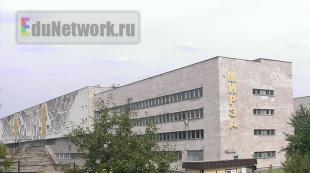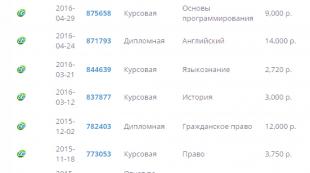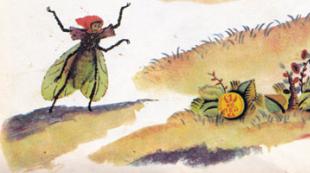Oxygen chemistry. Oxygen is a characteristic of an element, its abundance in nature, physical and chemical properties, production. Toxic oxygen derivatives
Sections: Chemistry
"Free oxygen is the most powerful agent of all the chemical bodies of the earth's crust known to us."
V.I. Vernadsky
Goals and objectives:
- Know the value of oxygen
- Know the history of the discovery of oxygen
- Know the properties of oxygen and its uses
- To be able to characterize oxygen as a chemical element and as a simple substance.
- To be able to draw up equations for the reactions of interaction of oxygen with metals and non-metals.
- To consolidate the ability to arrange the coefficients in the reaction equations.
Equipment and reagents:
For the experiment "Obtaining oxygen by decomposition of hydrogen peroxide in the presence of a catalyst": a metal stand, hydrogen peroxide (3% solution), manganese (IV) oxide, a flask, a funnel with a tap, a gas outlet tube, a beaker for collecting oxygen by air displacement, splinter, matches.
For the "Fireproof Handkerchief" experiment: alcohol, water, tongs, a handkerchief, two small crystallizers, matches.
T.S.O.
- Collection "Minerals"
- Mineralogy Handbook
- Computer, multimedia set-top box.
- Lesson presentation using materials from the "Educational Collection" ( Attachment 1)
- Oxygen in nature table
During the classes
1) Oxygen value
(slides 3-4)
Oxygen is human consciousness. It is especially necessary for the brain. Brain cells decompose and die without oxygen much faster than other cells in the body.
62% of a person's mass is the mass of all oxygen atoms that make up the body.
Oxygen is part of organic compounds: proteins, fats, carbohydrates, vitamins, enzymes, hormones.
The high oxidizing power of oxygen is the basis for the combustion of all types of fuel.
2) Characterization of oxygen as a chemical element
(slides 5-8)
- Chemical sign - Oh
- Latin name - Oxygenium,
- And r (O) = 16;
- valence - II,
- oxidation state in compounds: - 2;
- content in the earth's crust - I place - more than 49%,
- the most common oxides: hydrogen oxide (water) - H 2 O, silicon oxide - SiO 2, aluminum oxide - Al 2 O 3.
Demonstration of minerals:
- quartz – SiO 2 - this low temperature stable modification is usually referred to simply as quartz; the origin of the name remains unknown. Quartz is one of the most abundant in the earth's crust.
- amethyst –SiO 2
- rhinestone -SiO 2
- agate -SiO 2
- ruby - Al 2 О 3- one of the varieties of corundum
- emerald -Be 3Al 2 [Si 6O 18] - one of the varieties of beryl. Chemical composition: SiO 2 66,9%.Al 2O 3 19,0 %, BeO 14.1%, in the form of impurities contained Na 2Oh,K 2Oh,Li 2O sometimes Rb 2Oh,Cs 2O.
- alexandrite -BeAl 2O 4 - p A kind of chrysoberyl "chryso" in Greek is gold. Chemical composition . Al 2O 3 80,2 %. BeO 19.8%, Impurities are always present: FeO(3.5-6%), sometimes TiO 2(up to 3%) and Cr 2O 3(up to 0.4%), which is associated with the color of the alexandrite. The color of alexandrite is emerald green, and under electric light it is violet-red.
3) Characterization of oxygen as a simple substance
- Chemical formula - О 2, M r = 32; M = 32 g / mol.
- The atmosphere contains about 21% oxygen, (1/5 part).
- Every year, as a result of photosynthesis, 3000 billion tons of oxygen enters the Earth's atmosphere.
- The main suppliers of oxygen are tropical forests and ocean phytoplankton.
- A person inhales about 750 liters of oxygen per day.
- The complete passage of atmospheric oxygen through the biological circulation system is 2000 years!
4) Physical properties of oxygen
(slide 10)
- colorless gas, tasteless, odorless,
- slightly soluble in water,
- slightly heavier than air, (M air = 29 g / mol)
- liquefaction temperature = -183 ° C, blue liquid,
- freezing t = -218.8 ° C, blue crystals,
5) History of the discovery of oxygen
(slides 11-14)
- Ancient Greeks: "Air is a complex body."
- VIII century, China, Mao Hoa: “Air consists of“ full air ”(nitrogen) and“ incomplete air ”(oxygen).
- Karl Scheele, Sweden, experiments from 1768 to 1773: "Air research is currently the most important subject of chemistry." Received oxygen by heating nitrate.
1772 year:"Atmospheric air consists of two parts:" fiery air "- supports breathing and combustion," spoiled air "- does not support combustion." - Joseph Priestley, England, 1774: "But what struck me the most was that a candle burned in this air with an amazingly brilliant flame."
By heating the oxide of mercury, J. Priestley obtained a colorless gas that was little soluble in water and supported the burning of a candle. - Antoine Laurent Lavoisier, France, 1777
The true nature of this gas was established in France: Lavoisier found out that oxygen is a simple substance and what role it plays in oxidation processes. The name Oxygenium is "acid-begetting," proposed by Lavoisier.
6) Obtaining in the laboratory
Demonstration experiment (slide 15): get oxygen by decomposing potassium permanganate by heating; collect it by displacing air, confirm the presence of oxygen with a smoldering splinter:
2KMnO 4 = K 2 MnO 4 + MnO 2 + O 2
Demonstration experience : to obtain oxygen by the method of decomposition of hydrogen peroxide in the presence of a manganese (IV) oxide catalyst; collect it by displacing water, confirm the presence of oxygen with a smoldering splinter:
2 H 2 O 2 = 2H 2 O + O 2
7) Getting in the industry
liquefaction of air.
8) Chemical properties of oxygen
(slide 16)
- makes breathing easier;
- supports combustion;
- increases the temperature of the flame;
- accelerates chemical reactions;
Where and how does a person use these properties of oxygen?
- interacts with metals (slides 17-19)
Write down the reaction equations, arrange the coefficients, name the resulting substances. What are oxides?
Oxides are binary compounds of metals and non-metals with oxygen. In the first place in the oxide formula, the chemical sign of the element is written, in the second - the chemical sign of oxygen.
4Fe + 3O 2 = 2Fe 2 O 3
3Fe + 2O 2 = Fe 3 O 4
2Mg + O 2 = 2MgO
Fe 2 O 3 - iron (III) oxide, FeO - iron (II) oxide, (Fe 2 O 3 and FeO) - Fe 3 O 4- iron scale, MgO - magnesium oxide.
- interacts with non-metals; (slides 20-21)
Write down the reaction equations, arrange the coefficients, name the resulting substances
4P + 5O 2 = 2 P 2 O 5
2H 2 + O 2 = 2H 2 O
- interacts with complex substances, (slide 22) demonstration experience: "fireproof scarf":
C 2 H 6 O + 3O 2 = 2CO 2 + 3H 2 O
The reactions of interaction of simple and complex substances with oxygen are called reactions oxidation.
9) Consolidation of the studied material
(slides 23-25)
(chemical test):
Who called oxygen "fiery" and nitrogen "tainted" air?
What substances does the chemical element oxygen form?
A) only simple substances, B) simple and complex substances, C) only complex substances.
What are the names of binary compounds, the molecules of which are formed by atoms of some chemical element and oxygen:
A) sulfides, B) chlorides, C) oxides.
In 1774, after an experiment, one scientist wrote: "But what struck me the most was that a candle burned in this air with an amazingly brilliant flame ..." It was:
A) Lavoisier, B) Priestley, C) Scheele.
The name "Oxygenium" suggested:
A) Lavoisier, B) Priestley, C) Scheele.
Oxygen in water:
A) well soluble, B) slightly soluble, C) does not dissolve at all.
When oxygen is blown into the flame, the flame temperature is:
A) does not change, B) decreases, C) increases.
Iron (III) oxide has the formula:
A) Fe 2 O 3, B) FeO, C) FeO 2.
In which equation the coefficients are placed correctly:
A) 2P + O 2 = P 2 O 5; B) 2P + 5O 2 = P 2 O 5, C) 4P + 5O 2 = 2P 2 O 5
In which row are all three formulas written correctly:
A) P 2 O 5, Al 2 O, H 2 O; B) MgO, Al 2 O 3, CO 2; C) CO 2, FeO 2, P 2 O 5
Dictation check. (slide 26-27)
| Question number | Answer letter | Correct + Wrong - |
| 1 | FROM | |
| 2 | IN | |
| 3 | FROM | |
| 4 | IN | |
| 5 | BUT | |
| 6 | IN | |
| 7 | FROM | |
| 8 | BUT | |
| 9 | FROM | |
| 10 | IN |
Total:
Rating:
Criteria for evaluation:
- "5" - 10-9 correct answers
- "4" - 8-7 correct answers
- "3" - 6-5 correct answers
Introduction
Every day we breathe in the air we need so much. Have you ever thought about what, or rather what substances, the air consists of? Most of it contains nitrogen (78%), followed by oxygen (21%) and inert gases (1%). Although oxygen does not make up the most basic part of the air, without it the atmosphere would be unsuitable for life. Thanks to him, life exists on Earth, because nitrogen, both together and separately, is destructive to humans. Let's take a look at the properties of oxygen.
Physical properties oxygen
Oxygen in the air cannot be easily distinguished, since under normal conditions it is a gas without taste, color or smell. But oxygen can be artificially transferred to other states of aggregation. So, at -183 o C it becomes liquid, and at -219 o C it hardens. But solid and liquid oxygen can only be obtained by man, and in nature it exists only in a gaseous state. looks like this (photo). And solid is like ice.
The physical properties of oxygen are also the structure of the molecule of a simple substance. Oxygen atoms form two such substances: oxygen (O 2) and ozone (O 3). Below is a model of an oxygen molecule.

Oxygen. Chemical properties
The first thing that begins with the chemical characteristics of an element is its position in D.I.Mendeleev. So, oxygen is in the 2nd period of the 6th group of the main subgroup at number 8. Its atomic mass is 16 amu, it is a non-metal.
In inorganic chemistry, its binary compounds with other elements are combined into a separate one - oxides. Oxygen can form chemical compounds with both metals and non-metals.
Let's talk about getting it in laboratories.
Oxygen can be produced chemically by decomposing potassium permanganate, hydrogen peroxide, berthollet's salt, active metal nitrates and heavy metal oxides. Consider the reaction equations when applying each of these methods.
1. Water electrolysis:
H 2 O 2 = H 2 O + O 2
5. Decomposition of heavy metal oxides (eg mercury oxide):
2HgO = 2Hg + O 2
6. Decomposition of active metal nitrates (eg sodium nitrate):
2NaNO 3 = 2NaNO 2 + O 2
Oxygen application
We are done with the chemical properties. Now is the time to talk about the use of oxygen in human life. It is needed to burn fuel in electric and thermal power plants. It is used to produce steel from cast iron and scrap metal, for welding and cutting metal. Oxygen is needed for masks for firefighters, for divers' cylinders, it is used in ferrous and non-ferrous metallurgy and even in the manufacture of explosives. Also in the food industry, oxygen is known as food additive E948. There seems to be no industry where it is used, but it plays the most important role in medicine. There it is called "medical oxygen". In order for oxygen to be suitable for use, it is pre-compressed. The physical properties of oxygen make it compressible. In a similar form, it is stored inside cylinders similar to these.

It is used in intensive care and in operations in equipment to maintain vital processes in the body of a sick patient, as well as in the treatment of certain diseases: decompression, pathologies of the gastrointestinal tract. With its help, doctors save many lives every day. The chemical and physical properties of oxygen contribute to its widespread use.
>>
Chemical properties of oxygen. Oxides
This paragraph deals with:
> about the reactions of oxygen with simple and complex substances;
> about compound reactions;
> about compounds called oxides.
The chemical properties of each substance are manifested in chemical reactions with his participation.
Oxygen is one of the most reactive non-metals. But under normal conditions it reacts with few substances. Its reactivity increases significantly with increasing temperature.
Reactions of oxygen with simple substances.
Oxygen reacts, as a rule, when heated, with most non-metals and almost all metals.
Reaction with coal (carbon). It is known that coal heated in air to a high temperature ignites. This indicates a chemical reaction of the substance with oxygen. The heat generated in this process is used, for example, to heat houses in rural areas.
The main product of coal combustion is carbon dioxide. His chemical formula- CO 2. Coal is a mixture of many substances. The mass fraction of carbon in it exceeds 80%. Assuming that coal consists only of carbon atoms, we write the corresponding chemical equation:
t
C + O 2 = CO 2.
Carbon forms simple substances - graphite and diamond. They have a common name - carbon - and interact with oxygen when heated according to the given chemical equation 1.
Reactions in which one is formed from several substances are called compound reactions.
Reaction with sulfur.
This chemical transformation is carried out by everyone when they light a match; sulfur is part of its head. In the laboratory, the reaction of sulfur with oxygen is carried out in a fume hood. A small amount of sulfur (light yellow powder or crystals) is heated in an iron spoon. Substance first melts, then ignites as a result of interaction with atmospheric oxygen and burns with a barely noticeable blue flame (Fig. 56, b). A pungent smell of the reaction product appears - sulfur dioxide (we feel this smell at the moment a match is lit). The chemical formula of sulfur dioxide is SO 2, and the reaction equation is
t
S + O 2 = SO 2.
Fig. 56.Sulfur (a) and its combustion in air (b) and in oxygen (c)
1 In the case of insufficient oxygen, another carbon compound is formed with Oxygen- carbon monoxide
t
CO: 2C + O 2 = 2CO.

Fig. 57. Red phosphorus (a) and its combustion in air (b) and in oxygen (c)
If a spoon with burning sulfur is placed in a vessel with oxygen, then the sulfur will burn with a brighter flame than in air (Fig. 56, c). This can be explained by the fact that there are more O 2 molecules in pure oxygen than in air.
Reaction with phosphorus. Phosphorus, like sulfur, burns more intensely in oxygen than in air (Fig. 57). The reaction product is a white solid - phosphorus (\ /) oxide (its small particles form smoke):
t
P + O 2 -> P 2 0 5.
Turn a reaction scheme into a chemical equation.
Reaction with magnesium.
Previously, this reaction was used photographers for bright lighting ("magnesium flash") when taking pictures. In a chemical laboratory, the corresponding experiment is carried out as follows. Magnesium tape is taken with metal tweezers and set on fire in air. Magnesium burns out with a dazzling white flame (Fig. 58, b); you can't look at him! The reaction forms a white solid. This is a compound of Magnesium with Oxygen; its name is magnesium oxide.

Fig. 58. Magnesium (a) and its combustion in air (b)
Write an equation for the reaction of magnesium with oxygen.
Reactions of oxygen with complex substances. Oxygen can interact with some oxygen-containing compounds. For example, carbon monoxide CO burns in air to form carbon dioxide:
t
2CO + O 2 = 2CO 2.
We carry out many reactions of oxygen with complex substances in Everyday life burning natural gas (methane), alcohol, wood, paper, kerosene, etc. When they burn, carbon dioxide and water vapor are formed:
t
CH 4 + 20 2 = CO 2 + 2H 2 O;
methane
t
C 2 H 5 OH + 30 2 = 2C0 2 + 3H 2 O.
alcohol
Oxides.
The products of all the reactions considered in the paragraph are binary compounds of elements with Oxygen.
The compound formed by two elements, one of which is Oxygen, is called an oxide.
The general formula of oxides is EnOm.
Each oxide has a chemical name, and some also have traditional, or trivial 1, names (Table 4). The chemical name of the oxide consists of two words. The first word is the name of the corresponding element, and the second is the word "oxide". If an element has a variable valence, then it can form several oxides. Their names must be different. To do this, after the name of the element, indicate (without indentation) the value of its valence in the oxide in parentheses in Roman numerals. An example of such a name for a compound: cuprum (II) oxide (read "cuprum-two-oxide").
Table 4

1 The term comes from the Latin word trivialis - common.
conclusions
Oxygen is a chemically active substance. It interacts with most simple substances as well as complex substances. The products of such reactions are compounds of elements with oxygen - oxides.
Reactions in which one is formed from several substances are called compound reactions.
?
135. What is the difference between the reactions of combination and decomposition?
136. Convert reaction schemes into chemical equations:
a) Li + O 2 -> Li 2 O;
N2 + O 2 -> NO;
b) SO 2 + O 2 -> SO 3;
CrO + O 2 -> Cr 2 O 3.
137. Select from the given formulas those that correspond to oxides:
O 2, NaOH, H 2 O, HCI, I 2 O 5, FeO.
138. Give chemical names for oxides with the following formulas:
NO, Ti 2 O 3, Cu 2 O, MnO 2, CI 2 O 7, V 2 O 5, CrO 3.
Note that the elements that form these oxides are of variable valence.
139. Write down the formulas: a) plumbum (I \ /) oxide; b) chromium (III) oxide;
c) chlorine (I) oxide; d) nitrogen (I \ /) oxide; e) osmium (\ / III) oxide.
140. Add the formulas of simple substances in the reaction schemes and make up the chemical equations:
a) ... + ... -> CaO;
b) NO + ... -> NO 2; ... + ... -> As 2 O 3; Mn 2 O 3 + ... -> MnO 2.
141. Write down the reaction equations, with the help of which it is possible to carry out such "chains" of transformations, that is, from the first substance to obtain the second, from the second - the third:
a) C -> CO -> CO 2;
b) P -> P 2 0 3 -> P 2 0 5;
c) Cu -> Cu 2 O -> CuO.
142 .. Write the equations of reactions that occur when acetone (CH 3) 2 CO and ether (C 2 H 5) 2 O are burned in air. The products of each reaction are carbon dioxide and water.
143. Mass fraction of Oxygen in oxide EO 2 is equal to 26%. Define element E.
144. Two flasks are filled with oxygen. After they were sealed, excess magnesium was burned in one flask, and excess sulfur in the other. In which flask was the vacuum formed? Explain the answer.
Popel P.P., Kriklya L.S., Khimia: Pidruch. for 7 cl. zagalnoosvit. navch. prl. - К .: EC "Academy", 2008. - 136 p .: il.
Lesson content lesson outline and support frame lesson presentation interactive technologies accelerative teaching methods Practice tests, online testing tasks and exercises homework workshops and trainings questions for class discussions Illustrations video and audio materials photos, pictures, graphics, tables, diagrams comics, parables, sayings, crosswords, anecdotes, jokes, quotes Supplements abstracts cheat sheets chips for the curious articles (MAN) literature basic and additional vocabulary of terms Improving textbooks and lessons correction of errors in the textbook; replacement of outdated knowledge with new ones For teachers only calendar plans educational programs methodical recommendationsOxygen is one of the most important elements on our planet. The chemical properties of this substance allow it to participate in biological processes, and its increased activity makes oxygen a significant participant in all known chemical reactions. In a free state, this substance is present in the atmosphere. In a bound state, oxygen is part of minerals, rocks, complex substances that make up various living organisms. The total amount of oxygen on Earth is estimated at 47% of the total mass of our planet.
Oxygen designation
In the periodic table, oxygen occupies the eighth cell of this table. Its international name is oxigenium. In chemical records, it is designated by the Latin letter "O". Atomic oxygen does not occur in the natural environment, its particles combine to form paired gas molecules, molecular mass which is equal to 32 g / mol.
Air and oxygen
Air is a mixture of several gases common on Earth. Most of all in the air mass of nitrogen - 78.2% by volume and 75.5% by mass. Oxygen takes only the second place in terms of volume - 20.9%, and by weight - 23.2%. The third place is reserved for noble gases. The rest of the impurities - carbon dioxide, water vapor, dust, etc. - occupy only a fraction of a percent in the total air mass.
The entire mass of natural oxygen is a mixture of three isotopes - 16 O, 17 O, 18 O. The percentage of these isotopes in the total mass of oxygen is 99.76%, 0.04% and 0.2%, respectively.
Physical and chemical properties of oxygen
One liter of air under normal conditions weighs 1.293 g. When the temperature drops to -140⁰C, the air becomes a colorless transparent liquid. Despite its low boiling point, air can be kept liquid even at room temperature. For this, the liquid must be placed in a so-called Dewar vessel. Immersion in liquid oxygen radically changes the normal properties of objects.

Oxygen dissolves in water, albeit in small quantities - seawater contains 3-5% oxygen. But even such a small amount of this gas gave rise to the existence of fish, molluscs and various marine organisms that receive oxygen from the water to support their own life support processes.
The structure of the oxygen atom
The described properties of oxygen are primarily explained by the internal structure of this element.

Oxygen belongs to the main subgroup of the sixth group of elements periodic system... In the outer electron cloud of the element, there are six electrons, four of which occupy p-orbitals, and the remaining two are located in s-orbitals. Such internal structure causes high energy costs aimed at breaking electronic bonds - it is easier for an oxygen atom to borrow two missing electrons to the outer orbital than to give its six. Therefore, the covalence of oxygen in most cases is equal to two. Owing to two free electrons, oxygen easily forms diatomic molecules, which are characterized by a high bond strength. Only when the applied energy exceeds 498 J / mol, the molecules disintegrate, and atomic oxygen is formed. The chemical properties of this element allow it to react with all known substances, excluding helium, neon and argon. The rate of interaction depends on the reaction temperature and on the nature of the substance.

Chemical properties of oxygen
With various substances, oxygen enters into reactions of formation of oxides, and these reactions are characteristic of both metals and non-metals. Compounds of oxygen with metals are called basic oxides - the classic examples are magnesium oxide and calcium oxide. The interaction of metal oxides with water leads to the formation of hydroxides, which confirm the active chemical properties of oxygen. With non-metals, this substance forms acidic oxides - for example, sulfur trioxide SO 3. When this element interacts with water, sulfuric acid is obtained.
Chemical activity
Oxygen interacts directly with the overwhelming majority of elements. The exceptions are gold, halogens and platinum. The interaction of oxygen with some substances is greatly accelerated in the presence of catalysts. For example, a mixture of hydrogen and oxygen in the presence of platinum reacts even at room temperature. With a deafening explosion, the mixture turns into ordinary water, an important component of which is oxygen. The chemical properties and high activity of the element explain the release of a large amount of light and heat, which is why chemical reactions with oxygen are often called combustion.

Combustion in pure oxygen is much more intense than in air, although the amount of heat released during the reaction will be approximately the same, but the process proceeds much faster due to the absence of nitrogen, and the combustion temperature becomes higher.
Oxygen production
In 1774, the English scientist D. Priestley isolated an unknown gas from the decomposition of mercury oxide. But the scientist did not associate the emitted gas with the already known substance that is part of the air. Only a few years later, the great Lavoisier studied the physicochemical properties of oxygen obtained in this reaction, and proved its identity with the gas that is part of the air. IN modern world oxygen is obtained from air. In laboratories I use industrial oxygen, which is supplied in cylinders under a pressure of about 15 MPa. Pure oxygen can also be obtained in laboratory conditions; the standard method for its production is thermal decomposition of potassium permanganate, which proceeds according to the formula:
Ozone production
If electricity is passed through oxygen or air, then a characteristic smell will appear in the atmosphere, foreshadowing the appearance of a new substance - ozone. Ozone can also be obtained from chemically pure oxygen. The formation of this substance can be expressed by the formula:
This reaction cannot proceed on its own - external energy is required for its successful completion. But the reverse transformation of ozone into oxygen occurs spontaneously. The chemical properties of oxygen and ozone differ in many ways. Ozone differs from oxygen in density, melting point and boiling point. Under normal conditions, this gas is blue in color and has a characteristic odor. Ozone is more conductive and more soluble in water than oxygen. The chemical properties of ozone are explained by the process of its decay - when a molecule of this substance decomposes, a diatomic oxygen molecule is formed plus one free atom of this element, which reacts aggressively with other substances. For example, the reaction between ozone and oxygen is known: 6Ag + O 3 = 3Ag 2 O
But ordinary oxygen does not combine with silver even at high temperatures.

In nature, the active decomposition of ozone is fraught with the formation of so-called ozone holes, which endanger the life processes on our planet.
Sections: Chemistry
"Free oxygen is the most powerful agent of all the chemical bodies of the earth's crust known to us."
V.I. Vernadsky
Goals and objectives:
- Know the value of oxygen
- Know the history of the discovery of oxygen
- Know the properties of oxygen and its uses
- To be able to characterize oxygen as a chemical element and as a simple substance.
- To be able to draw up equations for the reactions of interaction of oxygen with metals and non-metals.
- To consolidate the ability to arrange the coefficients in the reaction equations.
Equipment and reagents:
For the experiment "Obtaining oxygen by decomposition of hydrogen peroxide in the presence of a catalyst": a metal stand, hydrogen peroxide (3% solution), manganese (IV) oxide, a flask, a funnel with a tap, a gas outlet tube, a beaker for collecting oxygen by air displacement, splinter, matches.
For the "Fireproof Handkerchief" experiment: alcohol, water, tongs, a handkerchief, two small crystallizers, matches.
T.S.O.
- Collection "Minerals"
- Mineralogy Handbook
- Computer, multimedia set-top box.
- Lesson presentation using materials from the "Educational Collection" ( Attachment 1)
- Oxygen in nature table
During the classes
1) Oxygen value
(slides 3-4)
Oxygen is human consciousness. It is especially necessary for the brain. Brain cells decompose and die without oxygen much faster than other cells in the body.
62% of a person's mass is the mass of all oxygen atoms that make up the body.
Oxygen is a part of organic compounds: proteins, fats, carbohydrates, vitamins, enzymes, hormones.
The high oxidizing power of oxygen is the basis for the combustion of all types of fuel.
2) Characterization of oxygen as a chemical element
(slides 5-8)
- Chemical sign - Oh
- Latin name - Oxygenium,
- And r (O) = 16;
- valence - II,
- oxidation state in compounds: - 2;
- content in the earth's crust - I place - more than 49%,
- the most common oxides: hydrogen oxide (water) - H 2 O, silicon oxide - SiO 2, aluminum oxide - Al 2 O 3.
Demonstration of minerals:
- quartz – SiO 2 - this low temperature stable modification is usually referred to simply as quartz; the origin of the name remains unknown. Quartz is one of the most abundant in the earth's crust.
- amethyst –SiO 2
- rhinestone -SiO 2
- agate -SiO 2
- ruby - Al 2 О 3- one of the varieties of corundum
- emerald -Be 3Al 2 [Si 6O 18] - one of the varieties of beryl. Chemical composition: SiO 2 66,9%.Al 2O 3 19,0 %, BeO 14.1%, in the form of impurities contained Na 2Oh,K 2Oh,Li 2O sometimes Rb 2Oh,Cs 2O.
- alexandrite -BeAl 2O 4 - p A kind of chrysoberyl "chryso" in Greek is gold. Chemical composition . Al 2O 3 80,2 %. BeO 19.8%, Impurities are always present: FeO(3.5-6%), sometimes TiO 2(up to 3%) and Cr 2O 3(up to 0.4%), which is associated with the color of the alexandrite. The color of alexandrite is emerald green, and under electric light it is violet-red.
3) Characterization of oxygen as a simple substance
- Chemical formula - О 2, M r = 32; M = 32 g / mol.
- The atmosphere contains about 21% oxygen, (1/5 part).
- Every year, as a result of photosynthesis, 3000 billion tons of oxygen enters the Earth's atmosphere.
- The main suppliers of oxygen are tropical forests and ocean phytoplankton.
- A person inhales about 750 liters of oxygen per day.
- The complete passage of atmospheric oxygen through the biological circulation system is 2000 years!
4) Physical properties of oxygen
(slide 10)
- colorless gas, tasteless, odorless,
- slightly soluble in water,
- slightly heavier than air, (M air = 29 g / mol)
- liquefaction temperature = -183 ° C, blue liquid,
- freezing t = -218.8 ° C, blue crystals,
5) History of the discovery of oxygen
(slides 11-14)
- Ancient Greeks: "Air is a complex body."
- VIII century, China, Mao Hoa: “Air consists of“ full air ”(nitrogen) and“ incomplete air ”(oxygen).
- Karl Scheele, Sweden, experiments from 1768 to 1773: "Air research is currently the most important subject of chemistry." Received oxygen by heating nitrate.
1772 year:"Atmospheric air consists of two parts:" fiery air "- supports breathing and combustion," spoiled air "- does not support combustion." - Joseph Priestley, England, 1774: "But what struck me the most was that a candle burned in this air with an amazingly brilliant flame."
By heating the oxide of mercury, J. Priestley obtained a colorless gas that was little soluble in water and supported the burning of a candle. - Antoine Laurent Lavoisier, France, 1777
The true nature of this gas was established in France: Lavoisier found out that oxygen is a simple substance and what role it plays in oxidation processes. The name Oxygenium is "acid-begetting," proposed by Lavoisier.
6) Obtaining in the laboratory
Demonstration experiment (slide 15): get oxygen by decomposing potassium permanganate by heating; collect it by displacing air, confirm the presence of oxygen with a smoldering splinter:
2KMnO 4 = K 2 MnO 4 + MnO 2 + O 2
Demonstration experience : to obtain oxygen by the method of decomposition of hydrogen peroxide in the presence of a manganese (IV) oxide catalyst; collect it by displacing water, confirm the presence of oxygen with a smoldering splinter:
2 H 2 O 2 = 2H 2 O + O 2
7) Getting in the industry
liquefaction of air.
8) Chemical properties of oxygen
(slide 16)
- makes breathing easier;
- supports combustion;
- increases the temperature of the flame;
- accelerates chemical reactions;
Where and how does a person use these properties of oxygen?
- interacts with metals (slides 17-19)
Write down the reaction equations, arrange the coefficients, name the resulting substances. What are oxides?
Oxides are binary compounds of metals and non-metals with oxygen. In the first place in the oxide formula, the chemical sign of the element is written, in the second - the chemical sign of oxygen.
4Fe + 3O 2 = 2Fe 2 O 3
3Fe + 2O 2 = Fe 3 O 4
2Mg + O 2 = 2MgO
Fe 2 O 3 - iron (III) oxide, FeO - iron (II) oxide, (Fe 2 O 3 and FeO) - Fe 3 O 4- iron scale, MgO - magnesium oxide.
- interacts with non-metals; (slides 20-21)
Write down the reaction equations, arrange the coefficients, name the resulting substances
4P + 5O 2 = 2 P 2 O 5
2H 2 + O 2 = 2H 2 O
- interacts with complex substances, (slide 22) demonstration experience: "fireproof scarf":
C 2 H 6 O + 3O 2 = 2CO 2 + 3H 2 O
The reactions of interaction of simple and complex substances with oxygen are called reactions oxidation.
9) Consolidation of the studied material
(slides 23-25)
(chemical test):
Who called oxygen "fiery" and nitrogen "tainted" air?
What substances does the chemical element oxygen form?
A) only simple substances, B) simple and complex substances, C) only complex substances.
What are the names of binary compounds, the molecules of which are formed by the atoms of a chemical element and oxygen:
A) sulfides, B) chlorides, C) oxides.
In 1774, after an experiment, one scientist wrote: "But what struck me the most was that a candle burned in this air with an amazingly brilliant flame ..." It was:
A) Lavoisier, B) Priestley, C) Scheele.
The name "Oxygenium" suggested:
A) Lavoisier, B) Priestley, C) Scheele.
Oxygen in water:
A) well soluble, B) slightly soluble, C) does not dissolve at all.
When oxygen is blown into the flame, the flame temperature is:
A) does not change, B) decreases, C) increases.
Iron (III) oxide has the formula:
A) Fe 2 O 3, B) FeO, C) FeO 2.
In which equation the coefficients are placed correctly:
A) 2P + O 2 = P 2 O 5; B) 2P + 5O 2 = P 2 O 5, C) 4P + 5O 2 = 2P 2 O 5
In which row are all three formulas written correctly:
A) P 2 O 5, Al 2 O, H 2 O; B) MgO, Al 2 O 3, CO 2; C) CO 2, FeO 2, P 2 O 5
Dictation check. (slide 26-27)
| Question number | Answer letter | Correct + Wrong - |
| 1 | FROM | |
| 2 | IN | |
| 3 | FROM | |
| 4 | IN | |
| 5 | BUT | |
| 6 | IN | |
| 7 | FROM | |
| 8 | BUT | |
| 9 | FROM | |
| 10 | IN |
Total:
Rating:
Criteria for evaluation:
- "5" - 10-9 correct answers
- "4" - 8-7 correct answers
- "3" - 6-5 correct answers









